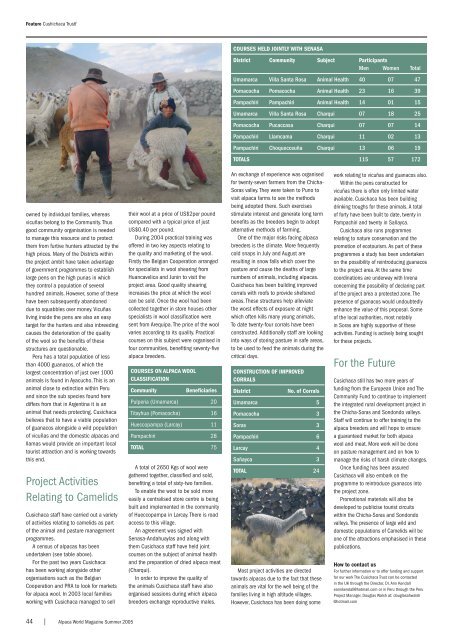Alpaca World Magazine Summer 2005 - Classical MileEnd Alpacas
Alpaca World Magazine Summer 2005 - Classical MileEnd Alpacas
Alpaca World Magazine Summer 2005 - Classical MileEnd Alpacas
- No tags were found...
Create successful ePaper yourself
Turn your PDF publications into a flip-book with our unique Google optimized e-Paper software.
Feature Cushichaca TrustfCOURSES HELD JOINTLY WITH SENASADistrict Community Subject ParticipantsMen Women TotalUmamarca Villa Santa Rosa Animal Health 40 07 47Pomacocha Pomacocha Animal Health 23 16 39Pampachiri Pampachiri Animal Health 14 01 15Umamarca Villa Santa Rosa Charqui 07 18 25Pomacocha Pucaccasa Charqui 07 07 14Pampachiri Llamcama Charqui 11 02 13Pampachiri Choquecceuña Charqui 13 06 19TOTALS 115 57 172owned by individual families, whereasvicuñas belong to the Community. Thusgood community organisation is neededto manage this resource and to protectthem from furtive hunters attracted by thehigh prices. Many of the Districts withinthe project ambit have taken advantageof government programmes to establishlarge pens on the high punas in whichthey control a population of severalhundred animals. However, some of thesehave been subsequently abandoneddue to squabbles over money. Vicuñasliving inside the pens are also an easytarget for the hunters and also inbreedingcauses the deterioration of the qualityof the wool so the benefi ts of thesestructures are questionable.Peru has a total population of lessthan 4000 guanacos, of which thelargest concentration of just over 1000animals is found in Ayacucho. This is ananimal close to extinction within Peruand since the sub species found herediffers from that in Argentina it is ananimal that needs protecting. Cusichacabelieves that to have a viable populationof guanacos alongside a wild populationof vicuñas and the domestic alpacas andllamas would provide an important localtourist attraction and is working towardsthis end.Project ActivitiesRelating to CamelidsCusichaca staff have carried out a varietyof activities relating to camelids as partof the animal and pasture managementprogrammes.A census of alpacas has beenundertaken (see table above).For the past two years Cusichacahas been working alongside otherorganisations such as the BelgianCooperation and PRA to look for marketsfor alpaca wool. In 2003 local familiesworking with Cusichaca managed to selltheir wool at a price of US$2per poundcompared with a typical price of justUS$0.40 per pound.During 2004 practical training wasoffered in two key aspects relating tothe quality and marketing of the wool.Firstly the Belgian Cooperation arrangedfor specialists in wool shearing fromHuancavelica and Junin to visit theproject area. Good quality shearingincreases the price at which the woolcan be sold. Once the wool had beencollected together in store houses otherspecialists in wool classifi cation weresent from Arequipa. The price of the woolvaries according to its quality. Practicalcourses on this subject were organised infour communities, benefi ting seventy-fi vealpaca breeders.COURSES ON ALPACA WOOLCLASSIFICATIONCommunity BeneficiariesPulperia (Umamarca) 20Titayhua (Pomacocha) 16Hueccopampa (Larcay) 11Pampachiri 28TOTAL 75A total of 2650 Kgs of wool weregathered together, classifi ed and sold,benefi ting a total of sixty-two families.To enable the wool to be sold moreeasily a centralised store centre is beingbuilt and implemented in the communityof Hueccopampa in Larcay. There is roadaccess to this village.An agreement was signed withSenasa-Andahuaylas and along withthem Cusichaca staff have held jointcourses on the subject of animal healthand the preparation of dried alpaca meat(Charqui).In order to improve the quality ofthe animals Cusichaca staff have alsoorganised sessions during which alpacabreeders exchange reproductive males.An exchange of experience was organisedfor twenty-seven farmers from the Chicha-Soras valley. They were taken to Puno tovisit alpaca farms to see the methodsbeing adopted there. Such exercisesstimulate interest and generate long termbenefi ts as the breeders begin to adoptalternative methods of farming.One of the major risks facing alpacabreeders is the climate. More frequentlycold snaps in July and August areresulting in snow falls which cover thepasture and cause the deaths of largenumbers of animals, including alpacas.Cusichaca has been building improvedcorrals with roofs to provide shelteredareas. These structures help alleviatethe worst effects of exposure at nightwhich often kills many young animals.To date twenty-four corrals have beenconstructed. Additionally staff are lookinginto ways of storing pasture in safe areas,to be used to feed the animals during thecritical days.CONSTRUCTION OF IMPROVEDCORRALSDistrictNo. of CorralsUmamarca 5Pomacocha 3Soras 3Pampachiri 6Larcay 4Sañayca 3TOTAL 24Most project activities are directedtowards alpacas due to the fact that theseanimals are vital for the well being of thefamilies living in high altitude villages.However, Cusichaca has been doing somework relating to vicuñas and guanacos also.Within the pens constructed forvicuñas there is often only limited wateravailable. Cusichaca has been buildingdrinking troughs for these animals. A totalof forty have been built to date, twenty inPampachiri and twenty in Sañayca.Cusichaca also runs programmesrelating to nature conservation and thepromotion of ecotourism. As part of theseprogrammes a study has been undertakenon the possibility of reintroducing guanacosto the project area. At the same timecoordinations are underway with Inrenaconcerning the possibility of declaring partof the project area a protected zone. Thepresence of guanacos would undoubtedlyenhance the value of this proposal. Someof the local authorities, most notablyin Soras are highly supportive of theseactivities. Funding is actively being soughtfor these projects.For the FutureCusichaca still has two more years offunding from the European Union and TheCommunity Fund to continue to implementthe integrated rural development project inthe Chicha-Soras and Sondondo valleys.Staff will continue to offer training to thealpaca breeders and will hope to ensurea guaranteed market for both alpacawool and meat. More work will be doneon pasture management and on how tomanage the risks of harsh climate changes.Once funding has been assuredCusichaca will also embark on theprogramme to reintroduce guanacos intothe project zone.Promotional materials will also bedeveloped to publicise tourist circuitswithin the Chicha-Soras and Sondondovalleys. The presence of large wild anddomestic populations of Camelids will beone of the attractions emphasised in thesepublications.How to contact usFor further information or to offer funding and supportfor our work The Cusichaca Trust can be contactedin the UK through the Director, Dr. Ann Kendalleannkendall@hotmail.com or in Peru through the PeruProject Manager, Douglas Walsh at: douglasahwalsh@hotmail.com44 | <strong>Alpaca</strong> <strong>World</strong> <strong>Magazine</strong> <strong>Summer</strong> <strong>2005</strong>







